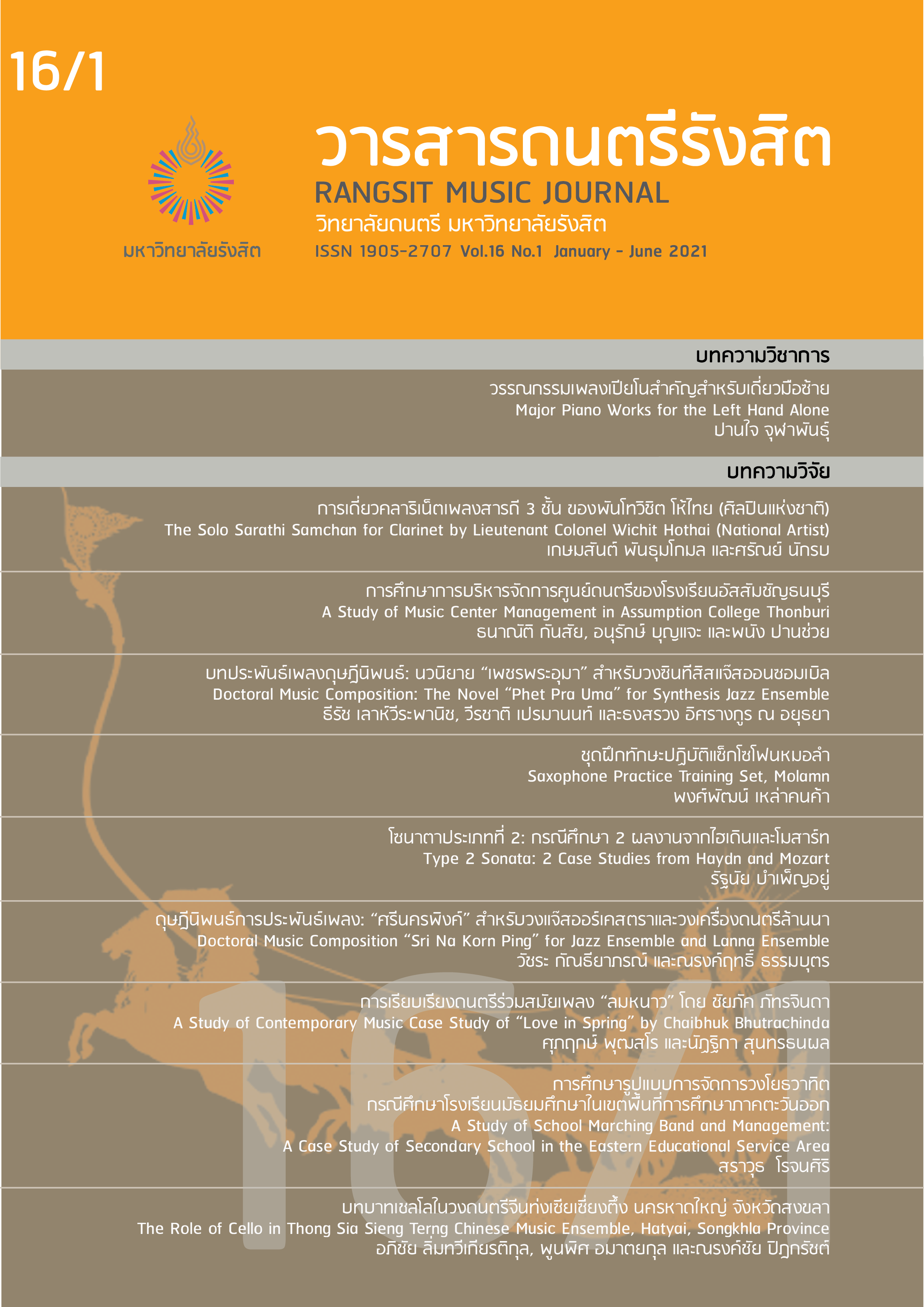The Role of Cello in Thong Sia Sieng Terng Chinese Music Ensemble, Hatyai, Songkhla Province
Keywords:
Cello, Thong Sia Sieng Terng Chinese Music Ensemble, Musical FormAbstract
This article employed a qualitative research method. It is a musicology study which aimed at studying the Thong Sia Sieng Terng Chinese music ensemble in the social and cultural context of Hat Yai City, Songkhla province, the role of the cello in the Thong Sia Sieng Terng Chinese music ensemble, and the musical form of cello in the Thong Sia Sieng Terng Chinese music ensemble. The research found the rituals and performances, a cello was used as a replacement for Tua Pha in the Thong Sia Sieng Terng Chinese music ensemble in 1988. It was responsible for both the main melody and the harmony in heterophony and polyphony patterns. It was played as the accompaniment during the Chinese monks’ chanting in many steps of the ritual especially playing with fingers while other instruments are silent. For all events, the cello is an indispensable instrument of the band because it serves as the only instrument which controls bass.
Most cello musical forms are binary with time signatures of 2/4 and 4/4. The phrases have a movement pattern of notes that do not exceed the fourth interval. The techniques for using a bow include Detache, Slurred Staccato, Martele, Portato, Tremolo, and Pizzicato. The techniques of Tonal answer, and Imitation are used with the melody.
References
เขียน ธีระวิทย์. วิวัฒนาการการปกครองของจีน. กรุงเทพฯ: ไทยวัฒนาพานิช, 2517.
งามพิศ สัตย์สงวน. การวิจัยเชิงคุณภาพเชิงมานุษยวิทยา. พิมพ์ครั้งที่ 5. กรุงเทพฯ: สำนักพิมพ์แห่งจุฬาลงกรณ์มหาวิทยาลัย, 2547.
จุลชีพ ชินวรรโณ. สัมพันธไมตรีไทย-จีน ทศวรรษแห่งมิตรภาพ. กรุงเทพฯ: โรงพิมพ์ มหาวิทยาลัยธรรมศาสตร์, 2528.
ธรรมศักดิ์ งานพงษ์ษา, สมาชิกวงดนตรีจีนท่งเซียเซี่ยงตึ้ง (ผู้ให้สัมภาษณ์). เมื่อวันที่ 27 มกราคม 2562.
พรพรรณ จันทโรนานนท์. งิ้วแต้จิ๋ว: ความเป็นมาและการแพร่กระจายเข้าสู่เมืองไทยในงิ้ว. กรุงเทพฯ: โรงพิมพ์มหาวิทยาลัยธรรมศาสตร์, 2543.
ลิขิต ฮุนตระกูล. ประวัติการสัมพันธ์ระหว่างชาติไทยกับชาติจีน. พิมพ์ครั้งที่ 7. ม.ป.พ., 2512.
วินัย พงศ์ศรีเพียร. ศิลปวัฒนธรรมไทย-จีน. กรุงเทพฯ: ศิริชัยการพิมพ์, 2532.
สุธน ปราชญาเปรื่อง, รองหัวหน้าวงดนตรีจีนท่งเซียเซี่ยงตึ้ง (ผู้ให้สัมภาษณ์). เมื่อวันที่ 27 มกราคม 2562.
Adler, Guido. “The Scope, Method, and Aim of Musicology (1885): An English Translation with an Historico-Analytical Commentary.” Yearbook for Traditional Music Vol. 13 (1981): 1-21.
Colaizzi, Paul. Psychological Research as the Phenomenologist Views It. New York: University Press, 1978.
Chen, Yongtao. The Chinese Christology of T.C. Chao. Boston: Brill, 2017.
Hood, Mantle. Musicology. 2nd ed. Princeton, NJ: Princeton University, 1965.
Schneider, Albrecht. “Comparative and Systematic Musicology in Relation to Ethnomusicology: A Historical and Methodological.” Ethnomusicology 50, 2 (2006): 236-258.







